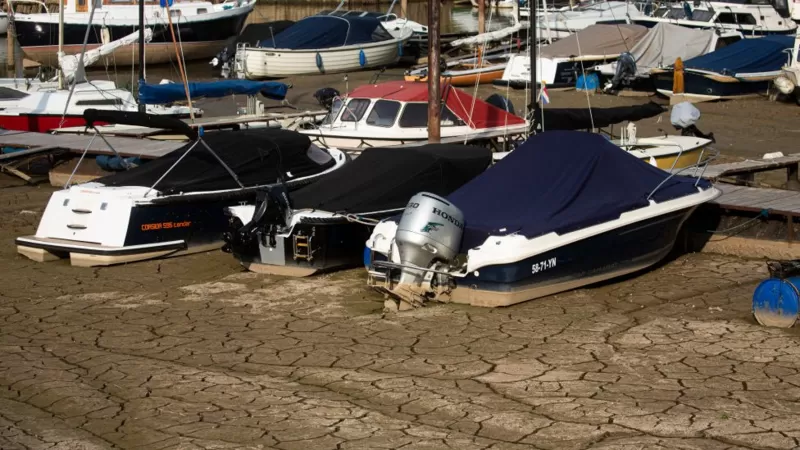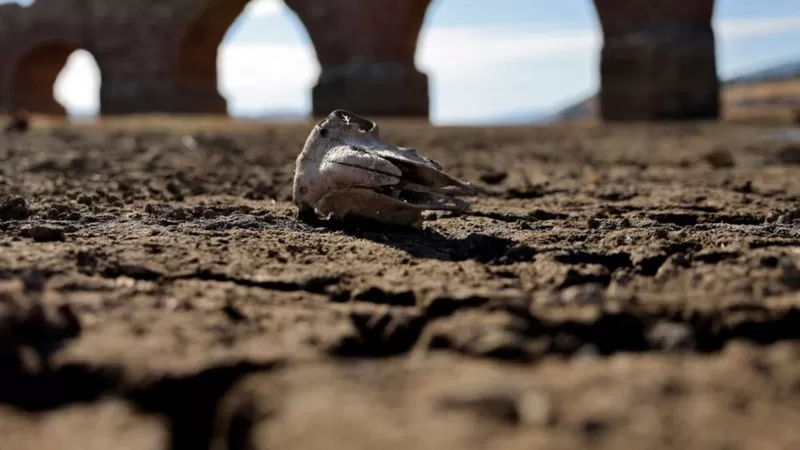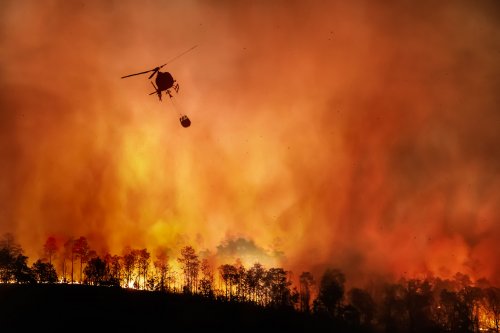Europe is suffering from a drought that may turn out to be the worst in half a millennium. The water level in the rivers has dropped so much that the so-called hunger stones have come to the surface, which predict a bad harvest and famine, and the operation of river transport in certain areas becomes impossible.
Read more about the shallowing of Europe's rivers and the situation in Ukraine on EcoPolitic.
Low river flow is a better indicator of the severity of the current drought than the commonly used rainfall deficit, as rivers are slow to respond to weather changes. Specialists do not expect the situation to improve quickly.
In the UK after prolonged dry weather, the source of the Thames in Gloucestershire has dried up and a weak current is now only visible 8 km downstream.
In many European countries, there is a tradition of hunger stones, which indicate a critically low water level. 27 stones are known in and around Germany, most of them are in the Elbe River.
The oldest known reference to a very low water level dates back to 1417. It was found in the Spree River near Berlin.
The history of hunger stones dates back to the 15th century. Early inscriptions date from 1417, 1473, 1616, 1654 and 1666.
Many of these stones with carvings or other works of art were placed during the famine years of 1816-1817, which followed the eruption of the Tambora volcano .

Hungry stone in the Decin region, Czech Republic
On such stones, the inhabitants of medieval Europe carved messages to their descendants, warning them of the danger of drought and famine due to lack of water. Such stones appeared in the Netherlands, Germany and the Czech Republic, in the Rhine and Elbe rivers.
The low water level in these rivers has exposed boulders on which carved inscriptions dating back to the XV-XVII centuries can be seen. On one of the stones in Elba, which is considered the oldest hydrological landmark in Central Europe, an inscription in German is carved: "When you see me, cry." This inscription, which warns of future troubles, dates back to 1616.
Newspapers in the 19th century wrote about the ominous appearance of hungry stones in European rivers. For example, in 1876, the Teplitzer Zeitung published a news story in which it was reported that the water level in the Elbe did not exceed one meter, and stones with dismal prophecies appeared near the shores. In those years, drought led to crop failure and, as a result, mass starvation and death.
In modern times, the inscription was noticed in 1918, when the stone was exposed during a low water period that coincided with the First World War famine.
The current drought in Europe has caused significant shallowing of large rivers. As a result, the stones, hidden from the eyes of people for centuries, protruded from the water.
The reason for the abnormal drought is that a blocking anticyclone has long been established over the territory of Western Europe, which prevents air masses from the Atlantic from penetrating deep into the continent. Thus, moisture bypasses the western coast of Europe, skirts it from the north and descends far to the east.

A stone in the German river Elbe, where you can read the engraved phrase: "Cry when you see me"
Never before has so little water flowed through the Rhine in the Netherlands - approximately 735 cubic meters of water per second. Even at its lowest point in 2018, it was 855 cubic meters per second.

The city of Beusichem in the Netherlands. Before the drought, there was a parking lot for yachts and boats at this place
Economic consequences
Many countries are currently experiencing water problems. The governments of European countries have appealed to citizens to use water sparingly, because the current drought poses a serious question regarding water supply throughout the continent.
In addition, the drop in water levels will call into question the logistics chains in Western Europe, as river transport will become problematic and even impossible. For example, the main transport artery of Europe, the Rhine River, can barely cope with the transportation of coal, which will lead to an acute shortage of raw materials at thermal power plants.
However, in France, the situation may be even more difficult, since the temperature of the water in the rivers does not allow it to be effectively used for cooling at the nuclear power plant. Therefore, the French have to reduce the amount of electricity production at nuclear plants.
Abnormal heat across much of Europe is having a negative impact on food production, energy, drinking water and wildlife.
Example in Italy, the dry Po River, the country's longest, has dropped to one-tenth of its normal rate, and the water level is 2 meters below normal. Due to the lack of prolonged rainfall in the region since November, the production of maize and risotto rice has been severely affected. The Po Valley accounts for 30-40% of Italy's agricultural production. As much as 60% of the rice crop can be lost as the fields dry up and are damaged by seawater that is "sucked up by the low river".

The bed of the Guardiana River in western Spain, August 16
The situation in Ukraine
Over 10,000 rivers disappeared in Ukraine during the years of independence.
Studies show that by the end of the century in most basins of Ukraine, the river flow will decrease significantly:
- In the Western Bug basin, the flow may decrease by an average of 28% to 30% in all months except February; the biggest decrease is expected in autumn (up to 32%).
- In the Dniester basin, according to the hard scenario, by the end of the century, a catastrophic decrease in flow is expected – in some months up to 36-38%.
- The decrease in the water flow of the Pripyat River basin will be in the range of 12–23%, but the decrease in the flow during the summer peak may reach 37%.
- No significant changes are predicted in the Desna basin, but in January-March, the river flow, on the contrary, may increase from 28% to 45%; in other months, a slight decrease in flow is expected.
- In the Southern Bug basin, at the end of the century, a significant decrease in the average annual flow is expected – up to 30%, and in some months up to 45%.
- In the Dnipro basin, the water flow is expected to decrease by an average of -20% (and up to 24% in summer), with a slight increase possible from January to March.
According to forecasts of specialists of the National Academy of Sciences, the Dnipro River may turn into a desert in 300 years due to chemical pollution.
Reasons for shallowing of small rivers of Ukraine:
- global warming;
- deforestation;
- contamination of the biotope with chemicals;
- soil and water pollution;
- excavating the soil from the stream
Rivers are also negatively affected by dams and hydroelectric power plants.
Environmentalist Tetiana Lampika explained that the ongoing military operations on the territory of Ukraine will significantly affect the pollution of water bodies and problems with filling rivers. The numerous destruction of bridges will lead to the stopping of the flow and the flowering of water bodies, and a large number of burials will have an impact in the context of groundwater poisoning, reports UNN.
Earlier, EcoPolitic wrote, that Europe suffering from severe drought, which could turn out to be the worst in 500 years, causing rivers to dry up.
As EcoPolitic previously reported, the shallowing of the Rhine River in Germany caused increase in prices for freight transportation.




